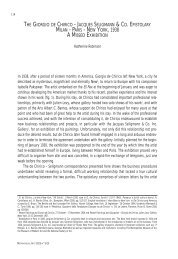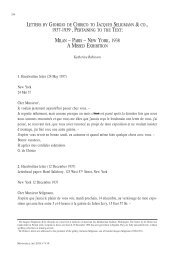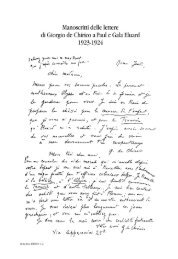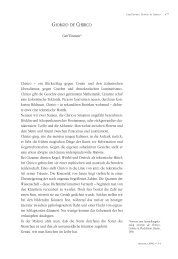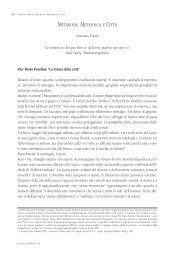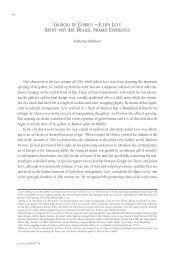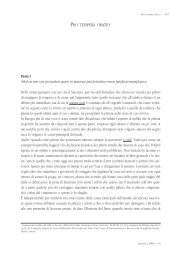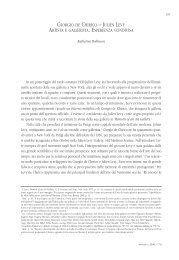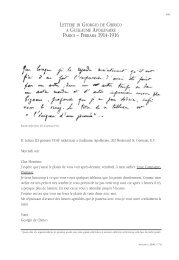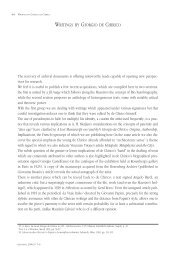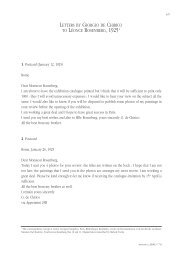Emplastic Oil - Fondazione Giorgio e Isa de Chirico
Emplastic Oil - Fondazione Giorgio e Isa de Chirico
Emplastic Oil - Fondazione Giorgio e Isa de Chirico
Create successful ePaper yourself
Turn your PDF publications into a flip-book with our unique Google optimized e-Paper software.
168<br />
SALVATORE VACANTI: FROM MURAL PAINTING TO “EMPLASTIC OIL”<br />
fig. 7 G. Usellini, The Storm, 1930,<br />
oil tempera on panel, Galleria Nazionale<br />
d’Arte Mo<strong>de</strong>rna, Rome<br />
tempera; we must especially abolish oil paint, a paint of gothic creation, a fierce enemy of “Italian”<br />
painting […]. As for me, I abandoned oil paint four years ago in favour of tempera that I have mo<strong>de</strong>lled<br />
after Pompeian paint […]. 43<br />
Savinio <strong>de</strong>fines Pompeian paint as wax tempera, and thus as “encaustic tempera” 44 . This interpretation<br />
evokes the formula for encausto outlined by <strong>de</strong> <strong>Chirico</strong> in his Small Treatise, where it was<br />
unsurprisingly referred to as Tempera a cera o incausto a freddo (wax tempera or cold encausto). 45<br />
Furthermore, Savinio’s praise of tempera as the symbol of an “artistic Italianism” and as antithetic<br />
to oil paint, an “enemy” of northern origins, may be traced back to theories proposed by <strong>de</strong> <strong>Chirico</strong><br />
ten years earlier. In the text La mania <strong>de</strong>l Seicento (The Craze of the Seventeenth Century), <strong>de</strong><br />
<strong>Chirico</strong> juxtaposed oil tempera, which he consi<strong>de</strong>red the utmost technique of the Italian<br />
Renaissance, to the “muddy” oil of the seventeenth century Flemish painters. 46<br />
De <strong>Chirico</strong>’s i<strong>de</strong>as on “craft” and his practical precepts circulated wi<strong>de</strong>ly through his essays and<br />
especially through the dissemination of the Small Treatise. Thanks to <strong>de</strong> <strong>Chirico</strong>’s influence, many<br />
artists became passionate about experimenting with painterly material at the turn of the <strong>de</strong>ca<strong>de</strong>.<br />
Amongst such painters was Gianfilippo Usellini, one of the youngest participants in the V Triennale<br />
“<strong>de</strong>coration workshop” 47 . An exponent of the Milanese Novecento art scene, the youthful artist used<br />
oil tempera on panel from his <strong>de</strong>but at the beginning of the 1920s. In the 1930s he began <strong>de</strong>dicating<br />
his time to mural painting and experimented with the ancient technique of encausto. Usellini’s<br />
poetic vision was expressed with a metaphysical connotation of both the everyday and the vision-<br />
43<br />
A Savinio, La nuova teoria sulle pitture pompeiane – tempera e affresco, in “La Stampa”, Turin, 21 July 1934; republished in M. Fagiolo <strong>de</strong>ll’Arco, op.<br />
cit. 1995, pp. 144-146.<br />
44<br />
See D. Fonti, Tutte le tecniche <strong>de</strong>ll’Argonauta, in Savinio, gli anni di Parigi, dipinti 1927-1932, exhibition catalogue edited by M. di Carlo, P. Vivarelli,<br />
Electa, Milan 1991, pp. 45-57.<br />
45<br />
G. <strong>de</strong> <strong>Chirico</strong>, Piccolo trattato…, cit., pp. 38-42.<br />
46<br />
G. <strong>de</strong> <strong>Chirico</strong>, La mania <strong>de</strong>l Seicento, in “Valori Plastici”, Rome, March 1921; now in G. <strong>de</strong> <strong>Chirico</strong>, Scritti/1…, cit., pp. 334-339.<br />
47<br />
Gianfilippo Usellini (Milan, 1903 - Arona, 1971) <strong>de</strong>veloped his vocation at the beginning of the 1920s in Milan’s art scene. He did not take part in the<br />
Milanese Novecento group, but was stylistically and thematically in tune with their i<strong>de</strong>a of mo<strong>de</strong>rn classicism. In 1933 he became interested in Sironi’s<br />
theories on mural painting and participated in the V Triennale, where he painted Le quattro età (The Four Ages of Man). See Gianfilippo Usellini 1903-<br />
1971, exhibition catalogue, E. Pontiggia, ed., Leonardo, Milan 1994.<br />
METAPHYSICAL ART 2010|N° 9/10



